Hey!!
I hope there is anyone who can help me with this topic..
For the stucture of a folding mechanism of foldable bicycle,
im trying to achive a mechanism, when pushing the seatpost to the front of the bicycle, the rear wheel will also be pushed simultaneously to the center of the bicycle under the frame.
after the short description i will try and explain the wanted outcome it visually:

how should i link the arm to the seatpost? i need a linkage system that will convert the movements.
any genious out there?
the "linkage system area" represnts the space to use extra arms or axis.
Thank you all!
I hope there is anyone who can help me with this topic..
For the stucture of a folding mechanism of foldable bicycle,
im trying to achive a mechanism, when pushing the seatpost to the front of the bicycle, the rear wheel will also be pushed simultaneously to the center of the bicycle under the frame.
after the short description i will try and explain the wanted outcome it visually:

how should i link the arm to the seatpost? i need a linkage system that will convert the movements.
any genious out there?
the "linkage system area" represnts the space to use extra arms or axis.
Thank you all!





